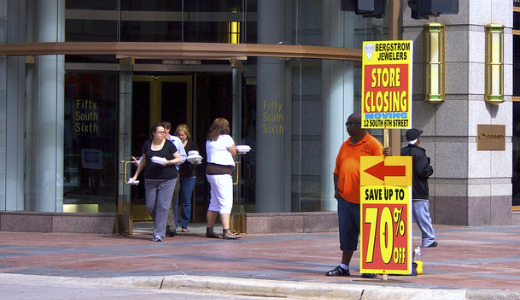
Demos, the Economic Policy Institute, the highly reliable Center on Budget and Policy Priorities, and the Century Foundation sponsored a live webcast conference Oct. 5 titled “America’s Fiscal Choices – Strengthening the Economy and Planning for the Future.” Panels of experts were convened on immediate, mid-term, and long-range approaches to fiscal and budget policy. They attracted top names of thinkers and policymakers from the left-to-moderate political and theoretical economics spectrums.
Paul Krugman, Nobel Prize winner, professor of international economics at Princeton and op-ed writer for the New York Times; Martin Feldstein, former chairman of Reagan’s Council of Economic Advisors, a member of the Group of Thirty and the Trilateral Commission; and Jan Hatzius, an economist for Goldman Sachs, all fundamentally agreed that the short-range options needed to address the crisis had grim prospects of becoming law in the increasingly polarized and paralyzed state of Congress.
All agreed that significantly more stimulus is required to reduce the unemployment numbers, but that political paralysis makes this step unlikely. Recovery means “demand-side initiatives” – raising incomes – are the only way out, especially when interest rates can no longer be reduced. Without direct government intervention in job creation, historic precedent-based hopes for recovery rest on areas showing no signs of life at all: exports and real estate. The trade surplus is currently worsening, not improving. And real estate is still bumping along the bottom of the Great Recession trough, with possible new surges in foreclosures – personal and commercial bankruptcies are still on the rise – and with further price declines and fewer new homes possible.
The emerging bankruptcy of numerous, and some very large, cities and states, including California, threatens the certainty of even the current “trough” of this recession. Robert Greenstein, chairman of the Center on Budget and Policy Priorities, on a separate panel, did a cogent survey of how the recession, combined in some areas with high levels of corruption, has caused state fiscal crises of unprecedented severity. Even with the current stimulus, states are already $70 billion in the hole. Now that the stimulus funds are nearly gone, state shortfalls are expected exceed $150 billion per year in the next two years, guaranteeing extremely sharp attacks on benefits, pensions and health care of public workers and retirees.
All three economists, representing a wide range of policy views, concurred that chances were 2 out of 3 that a 1.5 percent to 2.0 percent anemic GDP would be the best net result for this year, but also saw a 1 in 3 chance of slipping into another recession, with another net decline in GDP.
If political paralysis becomes the “new normal” alongside already sustained 10 percent to 25 percent unemployment levels in hundreds of communities, then all agreed that the compelling alternative to stimulus spending will be for the Federal Reserve to begin printing even more money, devaluing U.S. currency to inflate our way out of debt and, along with protectionist measures against China, and maybe Germany, maybe improve our exports (make them cheaper abroad). A weakened dollar may seem like a good idea in the short run, but will reflect a net loss of wealth in the long term. Prices for foreign goods and supplies will rise. When thinking foreign, do not forget the foreign supply chain components of many “American” goods. U.S. investments will look less attractive. Poverty and inequality may increase even further.
An afternoon panel chaired by Robert Kuttner dug into the stunning setbacks workers’ pensions have suffered in both the public and private sectors. Taken as a whole their rise and fall constitutes a modern morality play on the ultimate price paid by the failure to socialize important cradle-to-grave health care and retirement protections 70 years ago, and instead rely upon union contracts with the largest firms and private plans.
For public workers, the outright corruption behind billions in pension benefits stolen, diverted, or fraudulently promised by opportunistic politicians who never intended funding them, looms as a gigantic break of faith now being played out against public workers nearly everywhere. The various proposals to scale back Social Security, or privatize it, are viewed very skeptically as diversions from where all the scrutiny on costs should focus: on health care. The campaign against the health care reform law is not over. Boycotts, well funded misinformation campaigns, lawsuits, referenda, the candidacies from the tea party, most Republicans and a few of the Democratic Party candidates “are playing with budget fire” in jumping off the health care reform agenda, Kuttner warned.
A spirited discussion on the best approach to tax reform generally agreed that tax policy is a key means of insuring the fair distribution of income. Most favor a VAT – Value Added Tax – that would replace most existing taxes. Some favored modifiers on the tax side such as exemptions of necessities like food. Others favored income protection and enhancements on the program side while keeping tax rates constant and simple. Currently U.S. corporations have a higher tax rate than European Union competitors, but because of loopholes actually pay less, as do the rich in general.
All of the sessions were well prepared and will soon be made available online at Demos.
Conclusion: very stormy weather ahead!
Photo: Sign of the times, in Minneapolis. http://www.flickr.com/photos/kevinmjack/4947968025/ cc 2.0

MOST POPULAR TODAY


Zionist organizations leading campaign to stop ceasefire resolutions in D.C. area

High Court essentially bans demonstrations, freedom of assembly in Deep South

Afghanistan’s socialist years: The promising future killed off by U.S. imperialism

Communist Karol Cariola elected president of Chile’s legislature






Comments